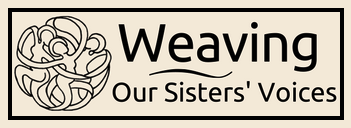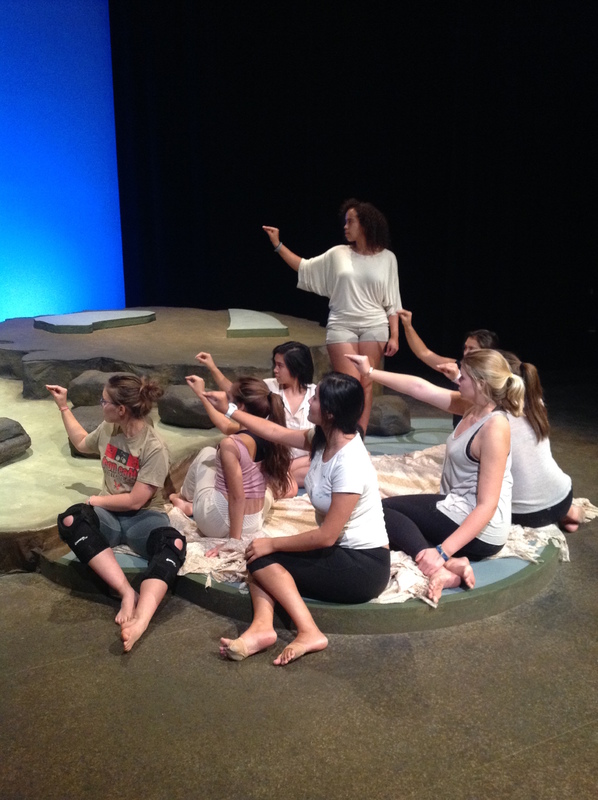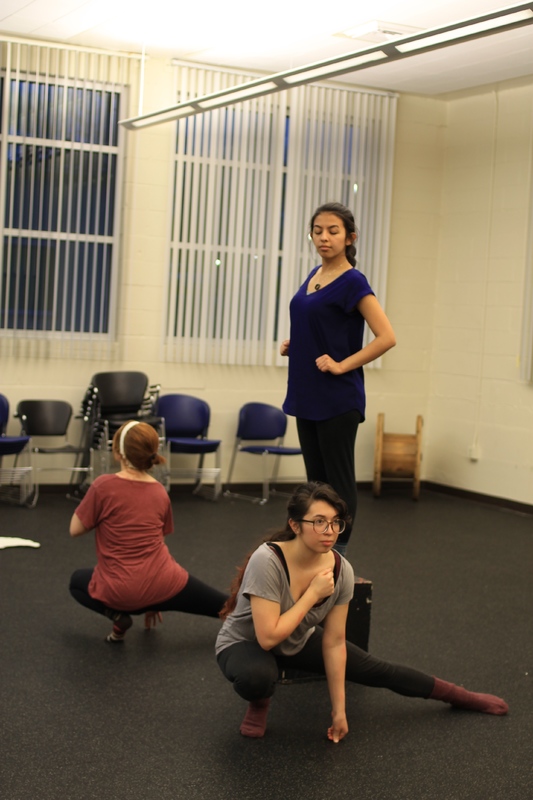ASL
Most stories within Weaving Our Sisters’ Voices illustrate women triumphing over adversity, and as a dancer much of my direction incorporated expressions of confidence through body language. With the 2015 Performance I wanted to explore this even fuller through the movement vocabulary of American Sign Language. Weaving Our Sisters’ Voices is about allowing a place and time to hear the voice of those that are not heard. In a way that is exactly what American Sign Language (ASL) is. I was not educated in it, but soon found one of my senior dance minors had taken it as her foreign language before she transferred to Gonzaga. I was quite delighted at the thought of Caley Edwards graduating but then being available to assist me with the incorporation of ASL into Weaving. Over the summer I shared the script with her, and we met multiple times looking at the key words we wanted to highlight with ASL in the performance. In addition to her having studied it and having a number of excellent books to reference, her sister-in-law was employed as an ASL interpreter, and was an excellent resource.
"I took ASL as my foreign language in college and I fell in love with it. I was nervous to be solely responsible to make sure the signs in WSV match what is being verbally said and make sure everything matched and was not offensive. (I also had help from my sister in-law Sara who is a sign language interpreter.)"
– Caley Edwards, ASL choreographer 2015
Using ASL was a glorious opportunity as a choreographer because it immediately gave us vocabulary of movement to explore. Ultimately it was important that this idea work as a method of being inclusive. I certainly didn’t want it to be any kind of gimmick. I wanted to build understanding for both hearing and non-hearing audience members as well as the cast.
We were all challenged. At first, learning to do the movements was awkward, but we kept thinking of it as movement vocabulary like dance. Eventually, it was beautiful to see the “norming and performing” kick in, and the students taking charge of their execution's effectiveness. They wanted to be sure to be consistent and would ask Caley questions, and rehearse as a group.
We invited Caley’s sister-in-law to come to one of the final rehearsals to be sure we were saying what we were meaning to say. She was very excited to celebrate the correctness of the way Caley taught the performers but also how we used it as dance. She affirmed that she also thought non-hearing audiences would appreciate the effort and she further shared that the awareness of the deaf community that using ASL would provide hearing audiences was important as well.
Our production was responded to for the Kennedy Center American College Theatre Festival by Jeff Sanders who is a director at Eastern Washington University. When he responded to the work after the show, his first question to himself was ‘what is the spine?’ and he concluded that it was “Let us make you whole”. Regarding the use of ASL he said it ‘socked me in the gut’ and had a hard time imagining the production without it. He said “The inclusiveness and heightened theatricality created a deeper reality within the performances”. He also mentioned the moment in particular when the woman with a hemorrhage says “faith in myself” using ASL and that it “deepened the punctuation of the experience and made me think everything should use this.”
In the post-show discussions for the 2015 performance, the audience always wanted to ask about the choice to use American Sign Language in the movement. I was able to speak from my perspective with choosing to use it as inspiration for the movement vocabulary. Caley Edwards spoke of the logistics of teaching it to this company. But it was the students talking about how it impacted them in their performance that was the most moving. They spoke of the day when Caley taught them that it wasn’t enough to just do the gestures right, that engaging the face and the whole body in the communication was part of ASL. There was a single moment during the Daughters of Zelophahead when the line is “Now daughters could inherent in Israel, not uncles, not male cousins, but daughters” The gesture for ‘but’ is two pointer fingers moving away from each other in an arch. Just making the gesture wasn’t enough, she said. They needed to engage their faces. This fed into all of the acting with the sign. The students said it was even more visceral for them to say the words with the signing because it was a true embodiment. The actor playing Job’s wife had a challenge of her monologue for the 2015 production. I chose to have her tell the story on her own. Usually I felt the stories were strengthened by having all the actors engaged and embodying part of the story. For the first two productions, I knew this to be a challenging monologue and I selected one of my strongest actors for the 2015 show. She admitted that it was difficult to get into the story at first and in particular because it was a true monologue. She choose to incorporate a lot of sign into her monologue, and the meaning grew in her performance. At a talk back, she spoke eloquently about how the gesture for "angry" was powerful, and saying the words “I was angry” was powerful – but the two together made the most impact. Because she made this connection to the emotion behind the story, there was a dramatic focus on her and this monologue, that helped ‘rest’ the audience experience after the complexity of the first couple stories of the performance.
So, while I may have failed to create a performance that would share the stories in their full glory to a deaf audience, the impact on student performers and some audience members made the experiment worth it. Plus, as an artist I found the opportunity to use this new language inspiring.
While Caley had worked to invite and encourage additional members of the deaf community to come to see the show and provide feedback, we were not aware of anyone that did attend this 2015 production. So we reached out to specialist Corrine Morrow a local Instructor ITP at Spokane Falls Community College. We invited her and her students to view the video of the production and share their thoughts.
While they did celebrate the show and feel it was “very moving and powerful!” they shared that we did not incorporate enough of the sign and “the Deaf are missing too much to be included…. The stories that each woman tells is so touching and informational. The Deaf are not getting the same message, because they only have access to pieces and parts.” In my desire to be inclusive, I was really not being fair to this segment of the audience. While I thought that the use of dance and theatricality would be worth watching on its own, she was pointing out that these are stories that are told to be understood. “Watch the production without volume and see what it is you get from it with only the sign used in the play.” Commented a student. “Pick out the signed words only, write them down and then read your notes… Does it match up with the entire story you are trying to tell?” Certainly not!
How arrogant am I that I thought what I directed and created would translate and be worth watching. I wanted a pat on the back from trying to include ASL to bring awareness and be inclusive. But, for crying out loud, Suzanne, this is a collection of stories to be understood and inspire! How could I think that just scratching the surface with some sign could give any audience member a powerful experience? And yet what were the goals of using it? We knew we were not fully translating the stories, but the benefits of using it came in other ways.
Suzanne Ostersmith


